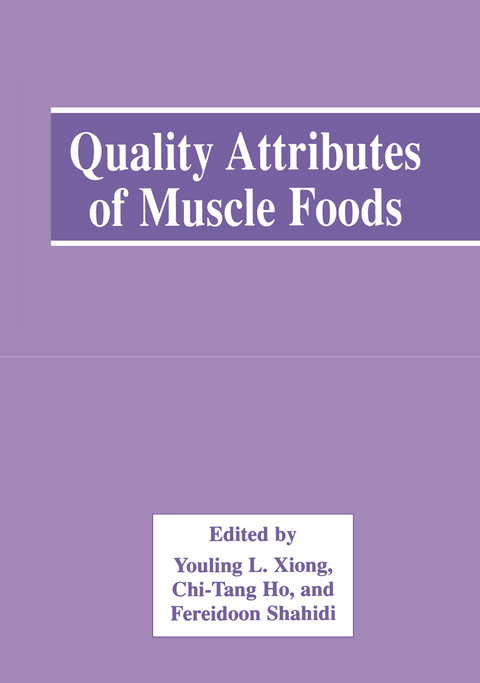
Quality Attributes of Muscle Foods
Springer-Verlag New York Inc.
978-1-4613-7144-1 (ISBN)
1. Quality Characteristics of Muscle Foods: An Overview.- 2. Animal Production Origins of Some Meat Color and Flavor Attributes.- 3. Vitamin E: Effect on Meat Color and Flavor.- 4. The High Energy Diet for Salmon: Effect of Fat on Muscle Quality.- 5. Accumulation of Conjugated Linoleic Acid (CLA) in Tissues of Fish Fed Diets Containing Various Levels of Cla.- 6. Quality and Shelf-Life of Meat in Case-Ready Modified Atmosphere Packaging.- 7. Storage Stability of Meat Products as Affected by Organic and Inorganic Additives and Functional Ingredients.- 8. Current Status of Meat Flavor.- 9. Flavor of Lamb and Mutton.- 10. Effect of Castration and Slaughter Age on the Flavor of Sheepmeat.- 11. Role of Selected Precursors in Meat Flavor Formation.- 12. Effect of Thiamin Oxidation on Thermal Formation of Meaty Aroma Compounds.- 13. Quality Attributes of Muscle Foods as Affected by Nitrite and Nitrite-Free Curing.- 14. Effect of Cooking on Consumers Perceptions of Mackerel (Scomber scombrus) of Poor Quality.- 15. Muscle Extracellular Matrix: Role in Growth, Development, and Meat Tenderness.- 16. Postmortem Mechanisms of Meat Tenderization: The Roles of the Structural Proteins and the Calpain System.- 17. Controlling Endogenous Enzyme Activity in Seafood.- 18. Oxidation of Fish Sarcoplasmic Reticular Lipids and Proteins.- 19. Association of Malonaldehyde with Rabbit Myosin Subfragment 1.- 20. Monoclonal Antibodies against Heat-Treated Muscle Proteins for Species Identification and End-point Temperature Determination of Cooked Meats.- 21. The Role of Proteins in Water-Holding Capacity of Meat.- 22. Phosphate-Mediated Water Uptake, Swelling, and Functionality of the Myofibril Architecture.- 23. Water Immobilization in Low-Fat Meat Batters.- 24. Advances in Determining Meat Emulsion Stability.- 25. Muscle Polymorphism and Gelling Properties of Myofibrillar Proteins from Poultry, Mammals, and Fish.- 26. Effect of Cathepsins B, L, L-Like and Calpain on the Protein Degradation of Surimi.- 27. The Role of Endogenous Proteases in Gel-Weakening of Beef Heart Surimi.- 28. Gelation Properties of Fish Proteins under Ohmic Heating.
| Zusatzinfo | IX, 433 p. |
|---|---|
| Verlagsort | New York, NY |
| Sprache | englisch |
| Maße | 178 x 254 mm |
| Themenwelt | Technik ► Lebensmitteltechnologie |
| ISBN-10 | 1-4613-7144-9 / 1461371449 |
| ISBN-13 | 978-1-4613-7144-1 / 9781461371441 |
| Zustand | Neuware |
| Haben Sie eine Frage zum Produkt? |
aus dem Bereich


